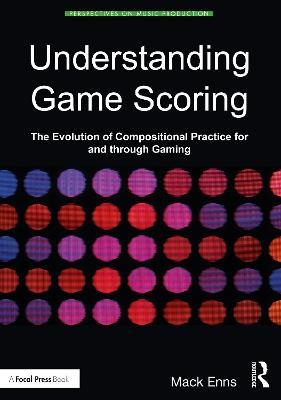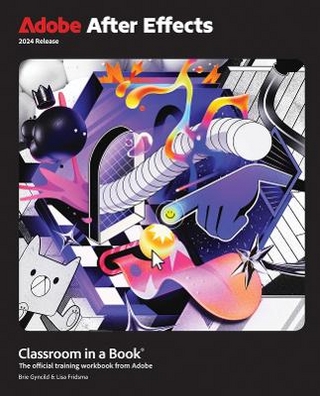
Understanding Game Scoring
CRC Press (Verlag)
978-0-367-49281-6 (ISBN)
- Titel z.Zt. nicht lieferbar
- Versandkostenfrei innerhalb Deutschlands
- Auch auf Rechnung
- Verfügbarkeit in der Filiale vor Ort prüfen
- Artikel merken
Using an array of case studies reaching back into the canon of classic video games, this book illuminates the musical flexibility, user interactivity and sound programming that make game scoring so different from traditional modes of composition. Mack Enns explores the collaboration between game scorers and players to produce the final score for a game, through case studies of the Nintendo Entertainment System sound hardware configuration, and game scores, including the canonic scores for Super Mario Bros. (1985) and The Legend of Zelda (1986).
This book is recommended reading for students and researchers interested in the composition and production of video game scores, as well as those interested in ludo-musicology.
Mack Enns is a Research Assistant Professor at Hong Kong Baptist University, specializing in music design and programming for video games and interactive media, music technology and popular music studies.
Contents
List of Figures
List of Tables
Chapter 1
An Introduction to Game Scoring
Disasterpeace and FEZ: A Case Study of Game Scoring
Music System Overview: Sequence Context Menu
Music System Overview: Scripts Browser
Music System Overview: Main Composition Sequencer
Game Scoring as an Unique Mode of Musical Composition
Methodology and Outline
Chapter 2
Game Scoring’s Interactive Multimedia Context
Spatial Emulation, the "Gaming Diegesis" and Game Scoring
Interactivity: A New Element
Audial Responsibility in the Interactive Multimedia Text: A Case Study of the Score for The Legend of Zelda (1987)
Case Study Conclusions: John Cage and Game Scoring as Aleatoric Composition
Game Scoring Taxonomy: Title Music
Game Scoring Taxonomy: Source Music
Source Music Case Study: Kondo’s "Lost Woods" Vs. Vreeland’s "Reflection"
Game Scoring Taxonomy: Results Music
Chapter Conclusions
Chapter 3
Game Scoring and Gaming Technology
Case Study: The Nintendo Entertainment System’s Sound Hardware Configuration
Channel Overview: Pulse Wave Channels
Channel Overview: Triangle Wave Channel
Channel Overview: Noise Channel
Channel Overview: Delta Modulation Channel
NES Game Scoring Techniques
NES Game Scoring Techniques: 2-Channel Echo
NES Game Scoring Techniques: Single Channel Echo
NES Game Scoring Techniques: Arpeggio and Psychoacoustic Block Chords
NES Game Scoring Techniques: TWC Kick Drum Sounds
NES Game Scoring Techniques: Melodic Samples
Putting It All Together: The APU Mixer
Case Study Summary
Game Scoring Taxonomy: Logo Jingles
Game Scoring Taxonomy: Loading Music
Game Scoring Taxonomy: Voice Acting and Vocals
Chapter Conclusions
Chapter 4
Game Design and Game Scoring as Software Programming
Game Scoring Taxonomy: Introduction Music
Game Scoring Taxonomy: Demo Music
Game Scoring Taxonomy: Gameplay Music
Gameplay Music: Hub Music
Gameplay Music: Area Music
Area Music Case Study: Game Scoring as Mimetic Music Technology in Tetris (1984) and Guitar Hero (2005)
Gameplay Music: Area Music, cont.
Gameplay Music: Time System Jingles
Gameplay Music: Battle Music
Gameplay Music: Rest Music
Gameplay Music: Dialogue Music
Dialogue Music Case Study: The Owl and Link’s Awakening (1993)
Gameplay Music: Challenge Music
Chapter Conclusions
Chapter 5
Game Scoring: Gameplay as Performance of Aleatoric Composition
Before Video Games: The Aleatoric Tradition
A Note on Sound Effects
Case Study: Super Mario Bros. (World 6-2)
Game Scores Vs. Game Soundtracks: Super Mario Bros. on CD
Case Study Conclusions
Game Scoring Taxonomy: Menu Sound Effects
Mario Menus: A Case Study of Menu Sound Effects in Two Super Mario Games
Menu Sound Effects, Cont.
Game Scoring Taxonomy: Menu Music
Game Scoring Taxonomy: Status Music (Gameplay Music, Cont.)
Game Scoring Taxonomy: Gameplay Sound Effects
Game Scoring Taxonomy: "Ambiences" or Ambient Sound Effects
Chapter Conclusions
Chapter 6
Game Scoring: Conclusion
Future Directions
Significance
Implications
Conclusion
Index
| Erscheinungsdatum | 23.11.2021 |
|---|---|
| Reihe/Serie | Perspectives on Music Production |
| Zusatzinfo | 14 Tables, black and white; 3 Line drawings, black and white; 101 Halftones, black and white; 104 Illustrations, black and white |
| Verlagsort | London |
| Sprache | englisch |
| Maße | 174 x 246 mm |
| Gewicht | 300 g |
| Themenwelt | Kunst / Musik / Theater ► Musik |
| Informatik ► Grafik / Design ► Film- / Video-Bearbeitung | |
| Informatik ► Software Entwicklung ► Spieleprogrammierung | |
| ISBN-10 | 0-367-49281-4 / 0367492814 |
| ISBN-13 | 978-0-367-49281-6 / 9780367492816 |
| Zustand | Neuware |
| Haben Sie eine Frage zum Produkt? |
aus dem Bereich


